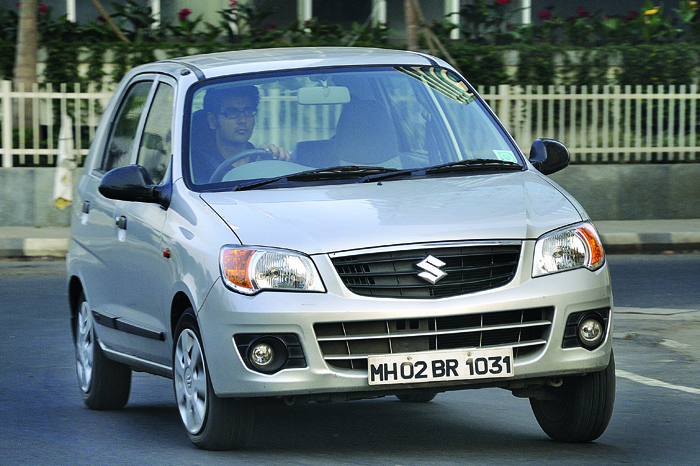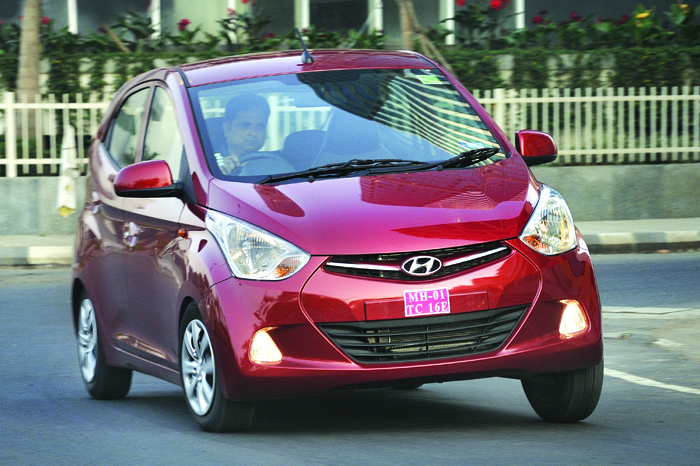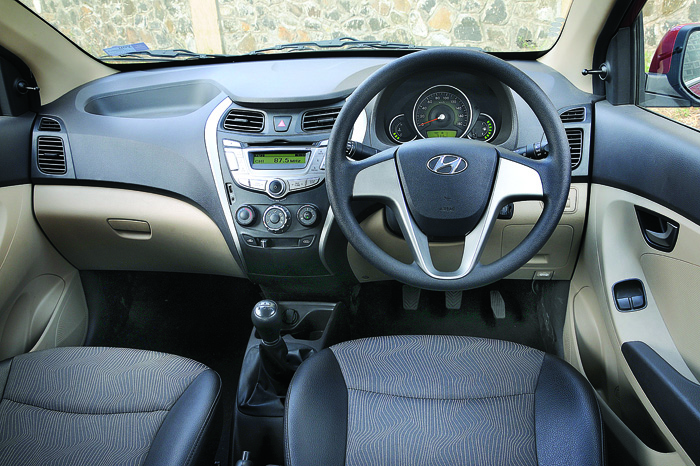At Nissan, Ghosn-san is God. Not only did he take a company that was $17 billion in debt and turn it into one of the most profitable car companies in the world, he also allowed Nissan’s engineers to indulge in their fantasies and build cars they could only dream of creating earlier. Here’s CEO Carlos Ghosn from way back: “Nissan needs a new story that’s different, a chapter in the life of a company that people want to write and want to remember.”
And it’s those very chapters that are standing right in front of us, basking in New Delhi’s early morning sunshine, soaking up the rays and the attention. Both these cars, it would be fair to say, wouldn’t exist without a mighty push from the CEO. The zero-emission electric Leaf, which Nissan began delivering in late 2010, is the world’s first mass-produced electric vehicle. Assembled on the same line as half a dozen other Nissan cars in Oppama, Japan, sales of the otherwise very normal electric car have recently taken off quite unexpectedly. But it was a hard sell for even the boss. Ghosn authorised a massive five billion US dollars to get the Leaf off the drawing boards and into showrooms, and he says the Leaf and its derivatives will be profitable for Nissan only six years down the line. That’s a long time and a big commitment to the future.
Nissan’s GT-R project, launched in earnest in 2003, was even more tumultuous. The Japanese car maker at the time was still deep in the red. Ghosn had just closed a bunch of factories in Japan and everyone thought he was nuts to push ahead with this expensive project. He didn’t want just a new GT-R, he wanted this to be the greatest GT-R ever. In typical fashion, he gave his engineers a very clear target: the new GT-R must blow the Porsche 911 turbo’s door off! This, of course, would mean an all-new platform, a brand new engine and more computing power and technology than a space shuttle. And it had to be affordable, less than half the price of supercars from Europe. Easy-peasy.
So it’s actually two very special cars we have here before us. Deciding on which car to get behind the wheel of first is dead simple, as we roll the shutters up at a downtown Nissan dealership early one Sunday morning. There, among a sea of Micras, Sunnys, Teanas and X-Trails sit our cars. The aggressive Godzilla-like T-Rex nose of the 2011 GT-R stands out like a toothy, leering wolf in a chicken coup, and the quirky pod-like headlamps of the Leaf make it look distinctly 23rd century. The Delhi fog is just lifting, 99.99 percent of the capital’s residents are lost to the world, tucked under their heavy quilts, and that means the roads are deserted. I head straight for the GT-R.
We inch out of the huge service area and head for the gate, but already there’s a problem. The dealership is located at a lower level than the road and the concrete ramp that links the two is so steep it resembles a submarine escape hatch. The low-slung Godzilla here has to be babied up a pair of steel ramps, and it’s a nerve-wracking process. But the GT-R cruises up quite easily in the end and soon the Leaf is up beside me too. However, I barely notice it, for, despite it emanating a deliberate whine at low speeds to alert pedestrians, it’s just so silent.
We’ve already been delayed and the sun’s just peeping over the horizon, so it’s chop, chop. Still, I run to the Leaf and stick my head in to tell colleague Saptarshi to take it easy with the Leaf as it’s only showing a range of 138km on the instrument panel display. And that’s if we drive like nuns, which is highly unlikely. Already, even before we’ve started, range anxiety is rearing its ugly head. We’ve checked the presence of the charging cable and the Indian adapter in the boot, but finding a willing ‘charging station’ out on the road in Delhi isn’t going to be easy.
So we tootle along for the first few minutes. The oil in the GT-R’s 523bhp VR38DETT twin-turbo V6 gets plenty of time to warm up nicely. I let the gearbox upshift early in auto and, with dampers set to ‘comfort’, the GT-R is nowhere near as harsh over the bumps as I remember it to be. I’ve been lucky enough to have logged plenty of hours behind the wheel of a GT-R and I can tell the ride of this updated car (easily identifiable by the strakes in the cladding, a new inverse grille and the bling LED lights — yetch) is far superior. And this updated GT-R is taking even some of the bigger bumps pretty well, quite an accomplishment on its 20-inch wheels.
Then, through the lifting fog, I see a wide curve in the road, followed by a long straight that disappears into the pea soup. What happens next is an unpremeditated synaptic response. Twin-clutch gearbox snaps down from fifth to second, the bottom of the accelerator pedal meets the carpet and the GT-R squats down and unleashes a continuous, never-ending explosion of power. I keep the throttle pinned for approximately 3-4 seconds and the acceleration is so violent it feels like a thermo nuclear device has gone off behind us. We’ve already demolished half the straight and I get a bit disoriented and jump off the throttle involuntarily. Whoa! They’ve gone and made it even more metal! Photographer Shafique in the passenger seat turns around with wide, crazed eyes, like I’ve just slapped him hard. “Pagal ho gaya kya?” he yells, lowering the window to help catch his breath, “At least warning do, yaar!”
Then, just as we crest one of Delhi’s numerous sweeping bridges, I catch a glimpse of another long, empty straight. “Okay, hold on,” I announce this time around and then double-click the left paddle again. It’s a long, descending corner and I’m accelerating pretty hard already, but the heavy and brilliantly balanced four-wheel-drive chassis feels just so tucked into the corner and perfectly poised, it all but begs me to pour in some more juice. And the more power I add, the more the four-wheel-drive system claws the tarmac. Weight nicely settled on the outside wheels, nose pointing exactly where I want it to, the GT-R rockets past the apex, pulling hard, the weighty and feelsome steering telegraphing a constant stream of info on the amount of grip present.
We are now upto silly speeds. Shrubs in the median flash past like a continuous green streamer and the road ahead is blurred several metres ahead, and yet the GT-R is as steady as a rock. After a good six- or seven-second squeeze on the throttle I suffer a mini panic attack again, let off the throttle and get smoothly onto the very reassuring Brembo brakes. And the GT-R shuts it all down, no drama, no histrionics. I see the needle dropping past 120 after I hit the brakes. Miles an hour, that is. A couple of tighter corners follow and GT-R allows me to attack them harder than I ever thought possible. The brakes are much more confidence-inspiring, the rear wheels almost talk to you and this GT-R, like every really good car, actually makes me seem like a better driver.
Further up the road, I pull over and wait for the Leaf, my head still buzzing with the display the new GT-R has put up. Maybe it’s just because you don’t expect it to be this good, but the GT-R, right here, right now, simply feels like one of the greatest supercars on the planet, price no bar. And there’s a new version out soon that the father of the GT-R, Kazutoshi Mizuno, says is significantly better still! He’s the same genius who’s famously fine-tuned all the loads — mechanical grip, aerodynamic downforce and weight from the engine and heavy rear gearbox/diff — to act on a single spot under each wheel. All I know is, if the Leaf has to knock the GT-R off its pedestal, it will have to be something else.
Later in the day, morning photography done, I get a chance to get behind the wheel of the Leaf. I’ve driven one only recently in Japan, and though that was on a test track, that car seriously impressed me. The shape has actually grown on me, especially those reptilian pod-like headlamps and the flying buttress rear, but I simply cannot get my head around the insides. More fridge than car, it feels like an alien spacecraft on the inside. But I guess that’s what Nissan wanted in the first place.
However, I’m sold on the Leaf just 10 minutes into the drive. We’re headed to the more crowded parts of old Delhi to see if the electric powertrain can cut it with all the stop-start traffic, and I am simply stunned by the super-refined, silent, smooth and torquey power delivery. Sure, pull the Leaf hard, wind the 107bhp electric motor to 10,000rpm, and it will whine in protest. But drive along at regular speeds on small throttle openings, and the electric motor’s max torque from start-up gives it an unnatural kick that makes it feel as effortless as an 8-litre engine. In fact, pedaling the Leaf in a relaxed manner reminds me of driving nothing less than Rolls. And that’s a compliment and a half. Just like the Roller, it has instant waftability, it has enough pace to effortlessly outpace regular traffic easily and even the ride quality on the long wheelbase and tall springs is very absorbent. Also a big help here is the very linear, friction-free steering. The Leaf was nimble enough to handle the tight lanes and the in-your-face traffic in old Delhi with ease. Throttle modulation was easy as pie, progression was jerk-free and it proved to be nimble enough too. Only thing was, I had to be constantly on the horn as the Leaf caught many a pedestrian by surprise.
However, the ‘Eco’ mode, which uses less energy, felt painful. The Leaf’s throttle responses are dulled excessively, the car becomes jerky to drive and I soon stopped enjoying the experience. So back it went to normal. Nissan’s biggest conquest has been that it has made the Leaf very normal to drive. But for the limited range, here is a car that functions like any everyday large hatch. You soon forget that you’re behind the wheel of something very different from the norm. You forget that you are sitting on top of a massive battery, you forget that there is no internal combustion engine under the hood and you forget that you can’t just roll into any petrol station and reset the range of the car in a few minutes. And that’s the biggest problem. You have to get accustomed to thinking in kilometres just to plan your day, and then the predicted range drops faster than you expect it to and you’re caught with your pants down.
Though we didn’t really need a top-up charge, we did go from door to door with the high-voltage plug in our hands. Truth be told, we didn’t get many favourable responses. The good people at KFC booted us out. “These tree huggers are the same bunch who holds dharnas for the humane treatment of our chickens. Throw them out,” muttered the manager under his breath. Often the wire proved to be too short too. Nissan clearly stipulates that it is dangerous to use an extension cable or box, and so we had to do quite a bit of running around. This depleted the battery further. Still, we did eventually find a kind, old lady who let us chuck our cable over her wall and get a brief charge.
In reality, however, the Leaf’s real-world range of approximately 120km is good enough for most people — few of us commute more than 40km one way. Sure, it lacks the flexibility of a regular liquid-fuelled car and charging it for between eight to 12 hours everyday isn’t easy either. But imagine how much you’d save on running costs if you’ve to buy electricity instead of petrol here in India.
And the future’s electric. EVs will only get better in the coming years. Laminated lithium-ion batteries like those on the Leaf will rapidly get smaller and more energy dense, charging will get faster and the range of electric cars will soon double. Like Ford’s model T however, the Leaf will always have a unique place in history as the first proper production electric car. And that really is big.
That the GT-R is part of the present and the Leaf part of the future there’s no doubt. The GT-R clearly is the best in its class and the Leaf undoubtedly the first. Come to think of it, they’d make for the ideal two-car garage: one super-efficient, refined and green for everyday use, the other just a mad, mad weekend warrior that can blow almost any car into the weeds. What do you think Carlos-sanhas parked in his garage?





























.jpg?w=728&q=75)
_6.jpg?w=728&q=75)
.jpg?w=728&q=75)
.jpg?w=728&q=75)
_0.jpg?w=728&q=75)
.jpg?w=728&q=75)
.jpg?w=728&q=75)
.jpg?w=728&q=75)
.jpg?w=728&q=75)
.jpg?w=728&q=75)
.jpg?w=728&q=75)
.jpg?w=728&q=75)
.jpg?w=728&q=75)
.jpg?w=728&q=75)
.jpg?w=728&q=75)
_0.jpg?w=728&q=75)
.jpg?w=728&q=75)
.jpg?w=728&q=75)








